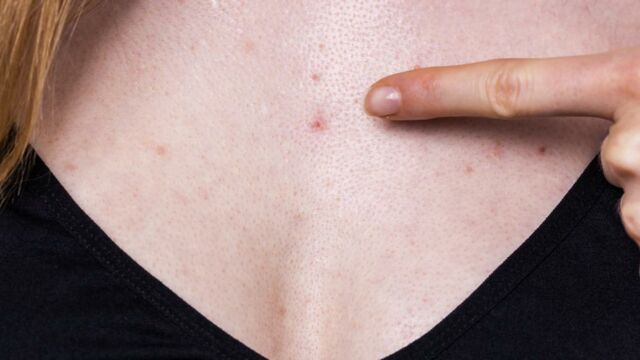Chest acne: Why we get it and how to get rid of it

When we think of acne, we often think about the face, but this uncomfortable condition can also affect our chests.
Acne on the face can be annoying, but imagine how much more aggravated your pimples become when they’re subject to the friction of your shirt. That’s just one of the reasons why we get chest acne. Other reasons why chest acne sucks include its ability to make us extremely self-conscious and that awful feeling of itchiness and irritation.
Discover our latest podcast
Summer is on the way, and with it comes pore-clogging sunscreen, sweat, bikinis and low cut dresses - not the best combination for chest acne sufferers. So, what better time to treat this irritating (but very common) condition?
More under this adMore under this adWhat is chest acne?
To understand how to treat chest acne, we first need to know what it is and why we might be suffering from it.
Chest acne is just another form of body acne, not dissimilar from the breakouts you’d get on your back or even your butt. In fact, pimples can pop up pretty much anywhere on the body, asides from the palms of the hands and the soles of the feet.
Chest acne can come in the form of both inflammatory or non-inflammatory acne. Types of chest acne pimples include:
- Nodules
- Cysts
- Papules
- Pustules
- Whiteheads
- Blackheads
Why do we get chest acne?
Just like any form of acne, chest acne is caused by excess sebum and dead skin cells that clog the pores. These pores then become the perfect home for P.acnes bacteria to reproduce. This bacteria then triggers an inflammatory response, resulting in a red and painful pimple. Many factors can jump-start this chest-acne causing process, including:
More under this adMore under this ad- Genetics
- Hormone fluctuations
- Stress
- Diet
- Restrictive clothing
- Harsh soaps and cleansers
- Sweat
- Medications
How to avoid chest acne
It may seem like chest acne is an inescapable part of life, but it there are some things you can do to prevent it:
Wear loose-fitting, natural fibres
You don’t have to throw away the tight-fitting tops and dresses. But, if you find yourself suffering from chest acne, then breathable fibres will help reduce friction and make it harder for bacteria to thrive.
Shower and change as soon as you can after exercise
Showering and changing after a sweat session will help ensure that the humidity and bacteria don’t get trapped in your clothes or clog your pores. If you don’t have time for a full shower, try using some wet wipes instead.
More under this adMore under this adUse hypoallergenic soaps and detergents
Using non-fragranced and hypoallergenic detergents can lessen the chances of skin irritation and, ultimately, acne.
Try to de-stress
If you think your chest acne may be caused by stress, try taking some time out for relaxing activities such as yoga or meditation.
Eat a healthy diet
If your diet could be to blame for your chest acne, try cutting out dairy and high-glycemic-index foods to see if your skin clears up.
More under this adMore under this adSee a doctor or dermatologist
Suppose nothing else is working, or your chest acne is caused by hormone imbalances or other medications. In that case, a doctor or dermatologist should be able to prescribe a treatment catered to your situation.
Best products to treat chest acne
While lifestyle changes can prevent chest acne, stepping up your body's skincare routine can clear any existing and future breakouts. When looking for products to treat chest acne, look for ingredients like salicylic acid, glycolic acid, lactic acid and benzoyl peroxide.
More under this adMore under this adThe Inkey List Salicylic Acid Cleanser

The Inkey List’s Salicylic Acid Cleanser is simple, affordable, and a chest acne targeting machine. This cleanser not only helps to remove any dirt and oil, but the salicylic acid acts as a mild exfoliant to promote healthy skin cell turnover.
More under this adMore under this adLa Roche-Posay Effaclar Micro-Peeling Purifying Gel Wash

La Roche-Posay’s Effaclar line is famous among the acne community. This foaming cleanser is made for oily skin and includes salicylic acid and zinc to relieve clogged pores and defeat acne-causing bacteria.
More under this adMore under this adMurad Clarifying Body Spray

If you want to clear up your chest acne for good, Murad’s Clarifying Body Spray is what you need. This quick-drying, exfoliating toner not only uses salicylic acid and glycolic acid but also includes allantoin and blue lotus extract to help calm inflammation and redness.
More under this adMore under this adPaula’s Choice Clear Extra Strength 2% BHA Exfoliant

This chemical exfoliant by Paula’ Choice is extra strength, perfect for those whose chest acne is stubborn and persistent. However, as it is a bit stronger, it’s maybe not the ideal product for those with sensitive skin. When using a strong exfoliant, it’s best to start using it once or twice a week before building up to every other day.
More under this adMore under this adACNECIDE Face Gel Spot Treatment Benzoyl Peroxide

If your chest acne isn’t responding to the usual ingredients like salicylic acid or glycolic acid, then it may be time to bring in the big guns - benzoyl peroxide. ACNECIDE’s benzoyl peroxide spot treatment acts as an anti-inflammatory to reduce redness and inflammation. All you need to do is apply a small amount to clean, dry skin.
More under this ad